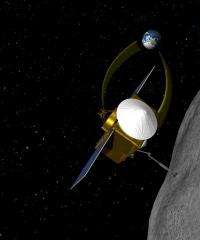NASA selects University of Arizona to lead sample return mission to asteroid

NASA has selected the University of Arizona to lead a sample-return mission to an asteroid. The team is led by Michael Drake, director of the the UA's Lunar and Planetary Laboratory. NASA Goddard Space Flight Center in Greenbelt, Md. will manage the mission for NASA. Lockheed Martin will build the spacecraft.
The OSIRIS-REx mission is budgeted for approximately $800 million, excluding the launch vehicle.
The target asteroid – named 1999 RQ36 after the year it was discovered – measures 575 meters (one-third of a mile) in diameter. 1999 RQ36 is a time capsule from the early solar system rich with organic compounds that may have seeded life on Earth.
"OSIRIS-REx will explore our past and help determine our destiny," said Drake. "It will return samples of pristine organic material that scientists think might have seeded the sterile early Earth with the building blocks that led to life. Such samples do not currently exist on Earth. OSIRIS-REx will also provide the knowledge that will guide humanity in deflecting any future asteroid that could collide with Earth, allowing humanity to avoid the fate of the dinosaurs."
OSIRIS-REx stands for Origins, Spectral Interpretation, Resource Identification, Security-Regolith Explorer.
Scheduled for launch in 2016, the OSIRIS-REx mission will return the first samples ever taken from a special type of asteroid holding clues to the origin of the solar system and likely organic molecules that may have seeded life on Earth.
OSIRIS-REx also will investigate an object potentially hazardous to humanity. 1999 RQ36 has a one-in-1,800 chance of impacting the Earth in the year 2182.
Spending longer than a year exploring 1999 RQ36 before acquiring samples, OSIRIS-REx will provide geologic context essential to expanding our understanding of the asteroid-comet continuum. The mission will provide near-live coverage of 1999 RQ36 operations and sample return to Earth. Samples will return to Earth in the year 2023.
The return to Earth of pristine samples with known geologic context will enable precise analyses that cannot be duplicated by spacecraft-based instruments. Pristine carbonaceous materials have never before been analyzed in laboratories on Earth.
The OSIRIS-REx instrument suite will include: the OSIRIS-REx Camera Suite (OCAMS) by the University of Arizona; the OSIRIS REx Visible-Infrared Spectrometer (OVIRS) instrument by NASA Goddard; the OSIRIS-REx Thermal Emission Spectrometer (OTES) by Arizona State University; and the OSIRIS-REx Laser Altimeter (OLA) by the Canadian Space Agency.
The team includes the University of Arizona, NASA Goddard Space Flight Center, Lockheed Martin, Arizona State University, KinetX, the Canadian Space Agency, NASA Johnson Space Center, NASA Ames Research Center, NASA Langley Research Center, along with science team members from across academia.
NASA New Frontiers is a program to explore the solar system with frequent, medium-class spacecraft missions that will conduct high-quality, focused scientific investigations designed to enhance our understanding of the solar system.
"OSIRIS-REx will usher in a new era of planetary exploration," said Dante Lauretta, the mission's deputy principal investigator and an associate professor at the UA's Lunar and Planetary Laboratory. "For the first time in space-exploration history, a mission will travel to, and return pristine samples of a carbonaceous asteroid with known geologic context. Such samples are critical to understanding the origin of the solar system, Earth, and life."
"OSIRIS-REx will have an extraordinary impact on the University of Arizona and our entire state," said UA President Robert N. Shelton. "For decades, our Lunar and Planetary Laboratory has made immeasurable contributions to our knowledge of the universe. This mission will continue and advance that tradition, with unique opportunities for our students and researchers."
Extensive characterization by the Arecibo Planetary Radar System, the Spitzer Space Telescope, and ground-based telescopes in Arizona and elsewhere have resulted in exceptional knowledge about the asteroid. 1999 RQ36 orbits the sun every 1.2 years, crossing the Earth's orbit every September. Its shape and rotation rate are well known, allowing OSIRIS-REx to make a safe, albeit short, touchdown.
"Our spacecraft will sneak up to RQ36 over the course of weeks," Lauretta said. "Once the two objects are traveling in sync, OSIRIS-REx will extend its sample collector, touch the surface for five seconds, collect well over 60 grams of sample, and get out of there."
Using an injection of ultra pure nitrogen, the OSIRIS-REx sample-collecting device will stir up dirt and small gravel to be captured and sealed for return to Earth. The samples are returned to the surface of the Earth using hardware and procedures successfully demonstrated on the Stardust mission, which returned samples from comet Wild 2 in 2006.
UA planetary science professor William Boynton is the mission instrumentation scientist, and Peter Smith, a professor in the UA's Lunar and Planetary Laboratory and principal investigator on the Phoenix Mars Mission, is the instrument scientist for the three on-board cameras. Heather Enos, project manager for the TEGA instrument on Phoenix, serves as the project planning and control officer. Chris Shinohara, science operations manager for the Phoenix Mission, will perform a similar role for OSIRIS-REx.
All mission science operations will be performed on the UA campus. Anna Spitz from the Mt. Lemmon Sky Center leads the Education and Public Outreach program. In addition to outstanding science and educational opportunities, OSIRIS-REx will provide a significant boost to the Arizona economy; approximately $200 million will be spent in Tucson and across Arizona.
Provided by University of Arizona




















